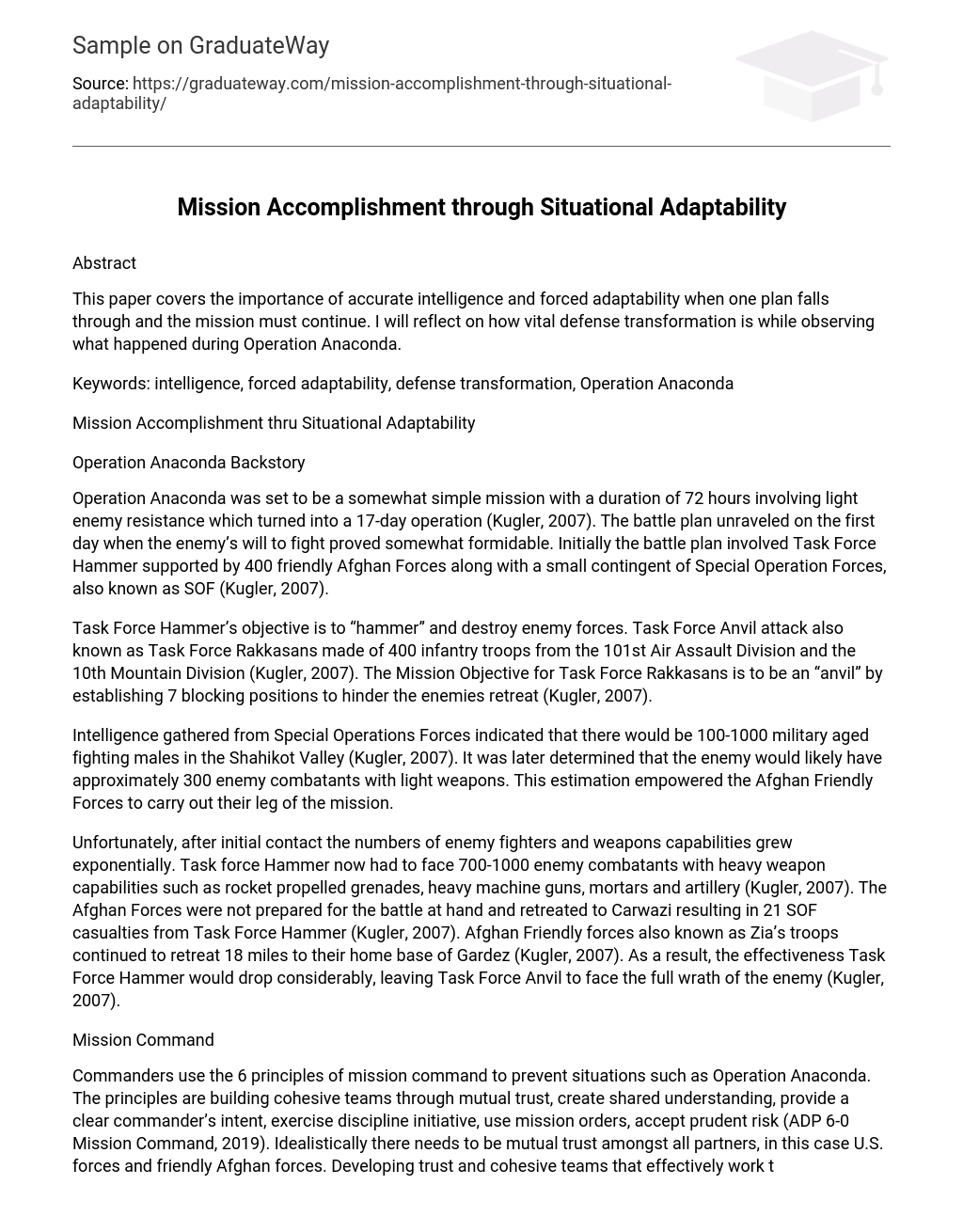Abstract
This paper covers the importance of accurate intelligence and forced adaptability when one plan falls through and the mission must continue. I will reflect on how vital defense transformation is while observing what happened during Operation Anaconda.
Keywords: intelligence, forced adaptability, defense transformation, Operation Anaconda
Mission Accomplishment thru Situational Adaptability
Operation Anaconda Backstory
Operation Anaconda was set to be a somewhat simple mission with a duration of 72 hours involving light enemy resistance which turned into a 17-day operation (Kugler, 2007). The battle plan unraveled on the first day when the enemy’s will to fight proved somewhat formidable. Initially the battle plan involved Task Force Hammer supported by 400 friendly Afghan Forces along with a small contingent of Special Operation Forces, also known as SOF (Kugler, 2007).
Task Force Hammer’s objective is to “hammer” and destroy enemy forces. Task Force Anvil attack also known as Task Force Rakkasans made of 400 infantry troops from the 101st Air Assault Division and the 10th Mountain Division (Kugler, 2007). The Mission Objective for Task Force Rakkasans is to be an “anvil” by establishing 7 blocking positions to hinder the enemies retreat (Kugler, 2007).
Intelligence gathered from Special Operations Forces indicated that there would be 100-1000 military aged fighting males in the Shahikot Valley (Kugler, 2007). It was later determined that the enemy would likely have approximately 300 enemy combatants with light weapons. This estimation empowered the Afghan Friendly Forces to carry out their leg of the mission.
Unfortunately, after initial contact the numbers of enemy fighters and weapons capabilities grew exponentially. Task force Hammer now had to face 700-1000 enemy combatants with heavy weapon capabilities such as rocket propelled grenades, heavy machine guns, mortars and artillery (Kugler, 2007). The Afghan Forces were not prepared for the battle at hand and retreated to Carwazi resulting in 21 SOF casualties from Task Force Hammer (Kugler, 2007). Afghan Friendly forces also known as Zia’s troops continued to retreat 18 miles to their home base of Gardez (Kugler, 2007). As a result, the effectiveness Task Force Hammer would drop considerably, leaving Task Force Anvil to face the full wrath of the enemy (Kugler, 2007).
Mission Command
Commanders use the 6 principles of mission command to prevent situations such as Operation Anaconda. The principles are building cohesive teams through mutual trust, create shared understanding, provide a clear commander’s intent, exercise discipline initiative, use mission orders, accept prudent risk (ADP 6-0 Mission Command, 2019). Idealistically there needs to be mutual trust amongst all partners, in this case U.S. forces and friendly Afghan forces. Developing trust and cohesive teams that effectively work together can be quite a challenge. Which was evident when the friendlies did not carry out their part of the mission forcing a vital component, adaptability. In order to be able to maneuver quickly and effectively teams must have a shared understanding with a collaborative approach. When a plan fails the mission continues.
Forced Adaptability
Forced adaptability is a major competency for modern battles. Original fire and maneuvers plans can be quickly thrown out, and tactical gears must shift. Inaccurate intelligence contributed to a near mission failure for Operation Anaconda. What started out as a ground only mission instantly turned into a collective ground and air defense transformation. Realizing that U.S. ground forces were under heavy machine guns and mortar fire from all directions which prohibited them from advancing and suppressing the enemy (Kugler, 2007). U.S Air forces not deemed important soon became the lifeline for the troops on ground.
Defense Transformation
With the insertion of U.S. Air Forces into the battles space, U.S. ground forces are now able to hit targets with precision airstrikes. Without defense transformation Operation Anaconda would have been an uttered failure. It enables the ability to attack from land, sea, and air by keeping pressure on the enemy. To engage in future battles U.S. forces must remain versatile, agile, and flexible in order to provide a wide spectrum of capabilities.
Conclusion
Defense transformation is a key component of success in modern day battles. Reflecting on Operation Anaconda, the mission would have failed tremendously if they were unable to adapt to a forever changing battlefield. Faulty intelligence, unreliable friendly forces, and unforeseen obstacles proved that we can not solely depend on ground forces and that we absolutely need to plan for air operations.
References
- ADP 6-0 Mission Command. (n.d.). Retrieved October 10, 2019, from https://usacac.army.mil/sites/default/files/misc/doctrine/CDG/adp6_0.html.
- Kugler, R. (2007). Operation Anaconda in Afghanistan: A Case Study of Adaptation in Battle.





